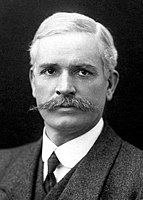| ||||||||||||||||||||||||||||||||||||||||
All 75 seats in the House of Representatives 38 seats were needed for a majority in the House 18 (of the 36) seats in the Senate | ||||||||||||||||||||||||||||||||||||||||
|---|---|---|---|---|---|---|---|---|---|---|---|---|---|---|---|---|---|---|---|---|---|---|---|---|---|---|---|---|---|---|---|---|---|---|---|---|---|---|---|---|
| Registered | 2,267,482 | |||||||||||||||||||||||||||||||||||||||
| Turnout | 1,349,626 (59.52%)[a] ( | |||||||||||||||||||||||||||||||||||||||
| ||||||||||||||||||||||||||||||||||||||||
 Results by division for the House of Representatives, shaded by winning party's margin of victory. | ||||||||||||||||||||||||||||||||||||||||
| ||||||||||||||||||||||||||||||||||||||||
The 1910 Australian federal election was held in Australia on 13 April 1910. All 75 seats in the House of Representatives, and 18 of the 36 seats in the Senate were up for election. The incumbent Liberal Party (formed by the fusion of the Protectionist Party and the Anti-Socialist Party in 1909) led by Prime Minister Alfred Deakin was defeated by the opposition Australian Labor Party (ALP) led by Andrew Fisher.
The election represented a number of landmarks: it was Australia's first elected federal majority government; Australia's first elected Senate majority; the world's first labour party majority government at a national level; after the 1904 Chris Watson minority and Fisher's former minority government the world's third labour party government at a national level; the first time it controlled both houses of a bicameral legislature; and the first time that a prime minister, in this case Deakin, was defeated at an election. It also remains the only election in Australia's federal history to have occurred following expiration of a full three-year parliamentary term by the "effluxion of time".[1] This was the first time the Labor Party won a federal election.
Two referendums to approve proposed amendments to the Constitution were held on the same day. The State Debts referendum was carried, but the Surplus Revenue referendum was not carried.
Future Prime Minister James Scullin and future opposition leader Matthew Charlton both entered parliament at this election. Scullin lost his seat at the subsequent 1913 election and did not re-enter parliament until 1922.
Cite error: There are <ref group=lower-alpha> tags or {{efn}} templates on this page, but the references will not show without a {{reflist|group=lower-alpha}} template or {{notelist}} template (see the help page).

